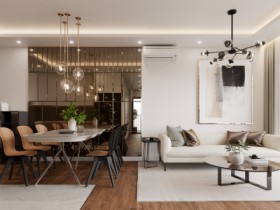Interior design is both an art and a science, a blend of creativity and practicality that transforms spaces into livable, functional and aesthetically pleasing environments. At Design In Vogue, we believe that the essence of good design lies in the perfect balance between form and function. This blog delves into the core principles of interior design, highlighting how aesthetics and functionality can be seamlessly integrated.
Understanding Aesthetics in Interior Design
Aesthetics in interior design pertains to the visual appeal of a space. It involves the careful selection of colors, textures, patterns, furniture and decor elements that create a harmonious and pleasing environment. The aesthetic aspect is often the first thing people notice when they enter a space. It sets the tone and mood, conveying a sense of style and personality.
At Design In Vogue, we approach aesthetics with a deep understanding of design principles such as balance, contrast, harmony, scale and proportion. We ensure that every element in a space contributes to a cohesive look. For instance, a modern minimalist design might feature clean lines, neutral colors and a clutter-free environment, while a traditional design might incorporate rich textures ornate furniture and warm hues.
The Role of Functionality
Functionality is the backbone of interior design. A space must not only look good but also serve its intended purpose efficiently. Functional design considers the practical aspects of a space, including layout, furniture arrangement, lighting and accessibility. It ensures that a space meets the needs of its occupants and enhances their experience.
For example, in a residential design, functionality might involve creating efficient storage solutions, ensuring adequate lighting for various activities and arranging furniture to facilitate easy movement and interaction. In a corporate design, functionality might focus on creating ergonomic workstations, collaborative spaces and incorporating technology seamlessly into the environment.
Balancing Aesthetics and Functionality
The true challenge in interior design lies in achieving a balance between aesthetics and functionality. At Design In Vogue, we follow a holistic approach where both elements are considered from the outset. We start by understanding the client's needs, preferences and lifestyle. This helps us develop a design concept that is both beautiful and practical.
For instance, in a kitchen design, we might choose elegant countertops and cabinetry that are also durable and easy to clean. In a living room, we might select stylish yet comfortable furniture that supports various activities like lounging, entertaining and reading.
Case Studies and Examples
To illustrate the balance between aesthetics and functionality, consider a few case studies from our portfolio. In a recent residential project, we transformed a small apartment into a cozy and stylish home. We used a neutral color palette to create a sense of space, incorporated multifunctional furniture to maximize utility and added personal touches through decor and accessories.
In a corporate project, we designed an open-plan office that promotes collaboration while providing private areas for focused work. We used glass partitions to maintain an open feel, incorporated ergonomic furniture and used branding elements to create a cohesive and professional look.
Conclusion
Balancing aesthetics and functionality is the hallmark of great interior design. At Design In Vogue, we strive to create spaces that are not only visually appealing but also enhance the quality of life for their occupants. By understanding and integrating the principles of both aesthetics and functionality, we ensure that every project we undertake is a perfect blend of beauty and practicality.

